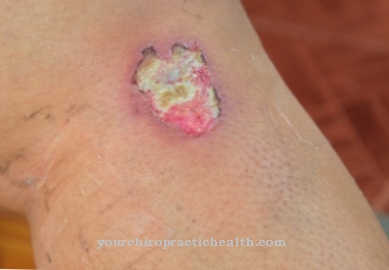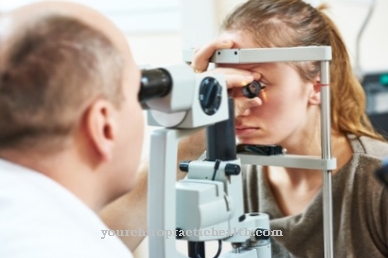Under a Razor burn skin redness and irritation are understood. The cause are often incorrect shaving techniques. It can arise where shaves are made on the body.
What is razor burn?

© Pavlo - stock.adobe.com
Razor burn is a common phenomenon. Medically it is called pseudofolliculitis barbae. It can arise in both men and women. Any part of the body that will be shaved can be affected. A razor burn is irritation to the skin.
They can be caused by reddening of the skin and irritation on the surface of the skin. A razor burn can occur in the short term as well as in the long term. Depending on the cause and measures taken, the duration and intensity vary. It is a change in the skin that causes pimples or itching. In particularly severe cases, there is an unpleasant burning sensation.
The razor burn is neither genetic nor transmissible. There are no impairments in everyday life. Usually the psychological complaints are more intense than the physical. People with naturally curly and strong hair are often more affected. A razor burn can lead to ingrown hairs and inflammation of the hair follicles.
causes
A razor burn occurs only in connection with performed shaves. The cause is based on the hair that is parted near the root of the hair during shaving. It can occur with dry shaves as well as with wet shaves. However, it is more likely to occur after a wet shave. With modern razors, the blades lift the hair slightly when you shave.
It is then cut off and the rest of the hair slides back under the surface of the skin. If the hair becomes twisted, it can no longer grow straight out of the pore. The skin pore closes and the hair has to look for another hair growth channel. The same problem arises if the hair changes direction of growth without lifting it beforehand.
Curvature of the hair is more common in people with naturally curly and thick hair. As a result, the hair continues to grow under the skin and looks for a new hair growth channel. Inflammation occurs on the hair follicle and pus forms. Another common cause is changes in shaving behavior. The hair maintains one direction of growth. However, if the shaving behavior changes, for example, from bottom to top to top to bottom, the position of the hair follicle automatically changes when shaving.
You can find your medication here
➔ Medicines against redness and eczemaDiseases with this symptom
- Hair follicle inflammation
- Hair root inflammation
- Bacterial infection
Symptoms, ailments & signs
The diagnosis is made after visual contact and a brief medical history. Further investigation methods are not required. A dermatologist should be consulted if the symptoms persist or if the razor burn is recurrent. The skin redness and inflammation are classified according to their severity so that appropriate measures can be taken.
The razor burn is divided into short-term and acute or long-term. The treatment methods are selected accordingly. In addition to the shaving behavior, the use of care products is checked for compatibility. The course of the disease can range from an increase in symptoms to spontaneous healing in the affected areas of the body with repeated shaves.
The burning sensation usually disappears after a few minutes or hours. The reddening of the skin will be minimized within days. In most cases, the inflammation also heals after a few days, provided that no further impurities are added. If you do not shave again, the course of the disease is remitting.
Complications
Aside from the anticipated skin irritation, razor burn can bring further complications. Possible discomforts can arise if the already irritated skin is treated with an alcohol-based aftershave or a care product with perfume. Then the itching often intensifies and there is also burning pain on the skin.
In addition, pathogens can more easily enter the immune system through the tiny skin injuries and lead to various complications. A possible complication can also be secondary infections, which in rare cases spread to the entire body and sometimes lead to itching and subsequently to severe discomfort.
The skin irritation can also lead to the formation of pimples and exacerbate existing acne. Pustules and papules occur less often after the razor burn, or ingrown hairs and other complications occur. A severe course can also lead to the formation of scars and permanent skin changes. The treatment of razor burn is usually free of complications. Creams and ointments that are supposed to relieve itching can lead to allergies and other irritations, especially if used improperly.
When should you go to the doctor?
A razor burn usually doesn't need to be treated by a doctor. However, if the symptoms persist longer than usual or recur, a visit to your family doctor is recommended. The symptoms may be due to an allergy or intolerance, which can usually be treated with simple measures.
Acute help is needed if severe infections or burn blisters occur as a result of shaving. A secondary infection can rarely develop that leads to severe discomfort and sometimes also to reddening of the skin and itching. Anyone who feels uncomfortable after a razor burn or observes other symptoms should therefore consult a doctor as soon as possible. This is especially true if the known home remedies and cooling the affected area do not promise relief.
In the event of an acute razor burn, preventive measures should first be taken. If the typical burning sensation occurs again despite taking appropriate precautions, medical advice should be sought for further clarification. Patients with skin or immune disorders should always have complaints clarified after shaving.
Doctors & therapists in your area
Treatment & Therapy
The treatment of razor burn can be done in the first steps with home remedies. The affected areas are cooled to close the pores. This can be done with compresses or ice cubes. It is recommended to apply care products with a calming effect to the affected areas of the skin. They include creams, chamomile, baby powder, or honey.
The irritation of the stressed skin is relieved and the symptoms are reduced. Wound and healing ointments can be applied overnight. Marigold tea, tea tree oil or St. John's wort can also be used. The skin needs sufficient rest in the event of a razor burn and should be protected.
In the event of acute razor burn, shaving must be stopped. It is only advisable to try again when the skin has recovered after a few minutes or hours. If the razor burn persists despite adequate preventive measures and the options mentioned, a family doctor should be consulted. Inflammation can then be treated with medication.
In the further course, the technique of shaving must be checked. Pressure on the blades should be reduced while shaving. It is also advisable to only shave small areas in one go. A relaxed atmosphere is helpful. The direction of shaving should be maintained on each attempt.
A change of the razor or a switch between wet and dry shaving can be tried out. If your hand is restless, it is advisable to ask someone else to shave. The care products must be matched to the respective skin type and adequate hygiene measures must be taken.
Outlook & forecast
There is no need to see a doctor if a razor burn occurs. This symptom is not an injury that requires urgent treatment. The razor burn usually heals after a few hours or, in the worst case, only after a few days. However, it is never so strong that a doctor has to be visited to treat the razor burn.
Most of the time, razor burn causes pain and tension on the skin. A burning sensation will develop and some areas of the face may bleed. This bleeding is not bad and usually stops after a few minutes. A handkerchief can be used to stop the bleeding more quickly. After the razor burn, smaller pimples can form on the face where the skin was cut too deeply. These pimples and other blemishes also heal relatively quickly and do not leave any scars.
To avoid razor burn, shaving foam should always be used. Alternatively, the use of an electric shaver is recommended. Treatment is therefore not necessary. The symptom heals on its own and therefore leads to a positive course of the disease.
You can find your medication here
➔ Medicines against redness and eczemaprevention
As a preventive measure, skin cleansing can be carried out before shaving. A peeling opens the pores. Regular shaving reduces the sensitivity of the skin's surface. The blades of the razor should be checked for cleanliness before shaving.
A clean and unused towel after the shave is also helpful and can be positioned within reach in advance. In advance, it is advisable to provide care products that are alcohol-free and minimize irritation.
You can do that yourself
No special medical treatment is usually necessary for razor burn. In order to avoid the razor burn itself, the person affected should definitely use a cream or shaving foam when shaving. This can avoid painful cuts in the skin. If the razor burn also occurs with the care product, the number of blades on the razor should be minimized. Modern razors often have four or five blades. For most skin types, razors with two or three blades at most are suitable. It is also possible to shave with an electric razor; in some cases this can prevent razor burn from occurring in the first place.
If the razor burn has occurred, the skin on the affected areas must be particularly spared and cared for. Oily care products that donate moisture to the skin are suitable here. For this reason, aloe vera is found in many care products, it soothes the skin and has cooling properties. So that no pimples or other skin blemishes develop on the affected areas, the area can be treated with an aftershave or aftershave. Small areas of bleeding must be washed off with water and also disinfected.
Razor burn can also be avoided if warm or hot water is used for shaving. The shave should always take place in the direction of growth. Instead of a conventional razor, a special razor can be used to prevent razor burn.





.jpg)


















.jpg)



